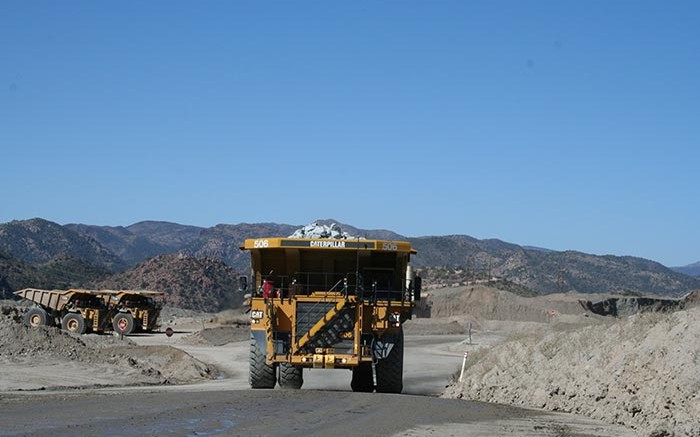VANCOUVER — On Jan. 20 copper producer Capstone Mining (TSX: CS; US-OTC: CSFFF) released its production and capital expenditure guidance for 2015, and the results don’t have analysts at BMO Capital Markets particularly enthusiastic. The company expects to produce 90,000 tonnes of copper in concentrates and cathode from its Pinto Valley, Cozamin and Minto mines at cash costs ranging from US$2 to US$2.10 per lb.
In addition, Capstone reported that its yearly budget was developed to “maintain financial flexibility, preserve the value of [its] development projects and maximize existing operations. The company’s US$149-million capital budget is well above BMO Research’s estimate of US$46 million, with the difference relating to timing of expenditures at Pinto Valley and higher stripping costs at Minto.
Capstone did report, however, that it has flagged US$36 million in capital that could be “deferred or cancelled” depending on the state of copper prices. The company is optimizing the performance of its Pinto Valley asset, which it acquired from BHP Billiton (NYSE: BHP; LSE: BLT) for US$650-million cash in April 2013.
“Our current cash balance and available credit facilities, along with tightly managed capital spending, will allow us to weather the volatility in the copper market well into the foreseeable future,” president and CEO Darren Pylot noted in the release. “We have put a flexible financing structure in place and developed a capital plan that will allow us to quickly adjust our spending, if required.”
Pinto Valley in Arizona is expected to account for most of production, with 56,300 tonnes of copper in concentrates expected this year. Grades are projected to average 0.4% copper, with Capstone’s focus involving stability at the mill facility and ongoing cost reductions. Total operating costs and costs per tonne mined are expected to fall year-over-year, and will average between US$2 and US$2.10 per lb. in 2015.
Capstone polished off an internal scoping study in 2014 to analyze a “significant amount of resources” at Pinto Valley not included in the initial mine plan. As a result, the company will advance two cases to prefeasibility, including a scenario that will include a 10–15% increase in throughput and the possibility of a mine life extension beyond 2026.
Meanwhile, the company’s Minto operation in the Yukon has been impacted by a delay in receiving surface mining permits for the Minto North expansion, which contains the property’s highest grade open-pit reserves. Capstone wagers it should receive its permits and begin pre-stripping at Minto North by March, with the mill processing 70% of its ore from stockpiles until the fourth quarter.
As such, cash-cost guidance includes US34¢ per lb. allocated from stockpile which was spent in 2014 and earlier, bringing cash spent during 2015 up to US$2.75 to US$2.85 per lb. Capstone does expect the cost profile to decrease each quarter as grade improves. The company is aiming to produce 18,000 tonnes of copper in concentrates at Minto, with cash costs pegged at between US$3.10 and US$3.20 per lb.
In Zacatecas, Mexico, Capstone estimates its Cozamin underground mine will crank out 18,000 tonnes of copper in concentrates at cash costs of between US$1.35 and US$1.45 per lb. Most of the ore will come from the San Roberto blocks in 2015, with the Mala Noche Footwall zone contributing 37% of ore production in 2015 at an average 1.8% copper grade.
On the development front Capstone will advance its Santo Domingo asset in Chile using what it calls a “stage-gate project management process.” The company anticipates it will receive an environmental-impact assessment on the project in the first quarter, which will trigger a decision on how to proceed with mine scheduling. Capstone reports that if “conditions warrant,” it could boost spending at the project to US$24 million in 2015.
“We [intend] to continue to advance our Santo Domingo development project in Chile in a measured and disciplined manner, with a number of steps in our stage-gate process to be completed prior to large capital expenditure commitments,” Pylot said.
BMO Capital Markets analyst Aleksandra Bukacheva noted that Capstone’s 2015 production guidance is 10% below estimates of 100,000 tonnes, with the shortfall largely attributed to the permitting delays at Minto. BMO Research rates Capstone’s stock as “outperform,” but is reducing its target price to $2.50 from $3 per share in light of valuation uncertainty, fuelled by higher capital expenditures.
Bukacheva added that the company has “ample” liquidity to withstand an extended downturn in copper prices, with US$400 million in “liquidity headroom.” That number includes US$176 million in cash and US$235 million in undrawn credit facilities.
Capstone has traded within a 52-week range of $1.15 to $3.35, and closed at $1.28 per share at press time. The company has 382 million shares outstanding for a $487-million market capitalization.


Be the first to comment on "Capstone’s 2015 outlook ‘disappointing,’ BMO says"